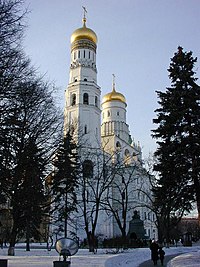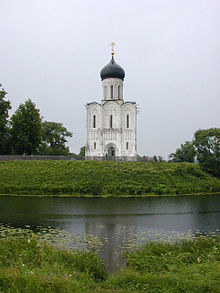| Revision as of 10:17, 21 September 2006 editPeter Isotalo (talk | contribs)Autopatrolled, Extended confirmed users, Pending changes reviewers22,553 edits Tweaked image not to encroach on the section header. "References" -> "Notes"; a reference section is a list of sources, not footnotes.← Previous edit | Revision as of 11:54, 21 September 2006 edit undoVanished user (talk | contribs)15,602 edits →Notes: Some of them are references, though. Change to "Notes and References"Next edit → | ||
| Line 40: | Line 40: | ||
| The domes are often brightly painted: their colours may informally symbolise different aspects of religion. Green, blue, and gold domes are sometimes held to represent the ], the Holy Spirit, and ], respectively. Black ball-shaped domes were once popular in the snowy north of Russia. | The domes are often brightly painted: their colours may informally symbolise different aspects of religion. Green, blue, and gold domes are sometimes held to represent the ], the Holy Spirit, and ], respectively. Black ball-shaped domes were once popular in the snowy north of Russia. | ||
| == Notes == | == Notes and References == | ||
| ] (1165)]] ] in ] (1687)—the height of the main drum and dome exceeds the height of the main cube of the church]] | ] (1165)]] ] in ] (1687)—the height of the main drum and dome exceeds the height of the main cube of the church]] | ||
| <references/> | <references/> | ||
Revision as of 11:54, 21 September 2006

An onion dome (Russian: луковица, lúkovitsa) is a type of architectural dome usually associated with Russian Orthodox churches. Such a dome is larger in diameter than the drum it is set upon and its height usually exceeds its width. These bulbous structures taper smoothly to a point, and strongly resemble the onion, after which they are named.
Other important types of Orthodox cupolas are antique helmet domes (for example, those of the Saint Sophia Cathedral in Novgorod and Assumption Cathedral in Vladimir), Ukrainian pear domes (Saint Sophia Cathedral in Kiev), and Baroque bud domes (St. Andrew's Church in Kiev).
History
Art historians disagree when and why onion domes became a typical feature of Russian architecture. Byzantine churches and architecture of Kievan Rus were characterized by broader, flatter domes without a special framework erected above the drum. In contrast to this ancient form, each drum of a Russian church is surmounted by a special structure of metal or timber, which is lined with sheet iron or tiles.
By the end of the nineteenth century, most Russian churches from before the Petrine period had bulbous domes. The largest onion domes were erected in the seventeenth century in the area around Yaroslavl, incidentally famous for its large onions. Quite a few had more complicated bud-shaped domes, whose form derived from Baroque models of the late seventeenth century. Pear-shaped domes are usually associated with Ukrainian Baroque, while cone-shaped domes are typical for Orthodox churches of Transcaucasia.
Traditional view

The earliest academic researchers of Russian architecture pointed out that Russian icons painted before the Mongol invasion of Rus do not feature churches with onion domes. Furthermore, two highly venerated pre-Mongol churches that have never been rebuilt—the Assumption Cathedral and the Cathedral of St. Demetrius in Vladimir—uniquely display golden helmet domes. Restoration works on several other ancient churches revealed some fragments of former helmet-like domes below newer onion cupolas.
Based on these findings, it was concluded that ancient Russian churches were helmet-shaped while onion domes had been introduced considerably later. It was posited that onion domes first appeared during the reign of Ivan the Terrible. Indeed, the bulbous, wildly coloured domes of Saint Basil's Cathedral have not been altered since the reign of Ivan's son Fyodor I, clearly indicating that onion domes did exist in sixteenth-century Russia.
Some scholars even postulated that onion domes were borrowed by Russians from Muslim countries, probably from the Khanate of Kazan, whose conquest Ivan the Terrible commemorated by erecting St. Basil's Cathedral. Others argued that onion domes first appeared in wooden architecture of the Russian North, above tent-like churches. According to this theory, onion domes were strictly utilitarian, as they prevented snow from piling on the roof.
This theory became firmly entrenched in Soviet architectural theory. Based on the notion that onion domes did not exist in Russia before the mid-sixteenth century, restoration works on churches built before the seventeenth century have routinely involved replacement of onion domes with "more authentic" helmet-shaped domes. One example of such restoration is the Dormition Cathedral in the Moscow Kremlin.
Alternative theories
In 1946, the historian Boris Rybakov, while analysing miniatures of ancient Russian chronicles, pointed out that most of them, from the thirteenth century onward, display churches with onion domes rather than helmet domes. Nikolay Voronin, the foremost authority on pre-Mongol Russian architecture, seconded his opinion that onion domes existed in Russia as early as the thirteenth century, although they presumably could not be widespread. These findings demonstrated that Russian onion domes could not be imported from the Orient, where onion domes did not replace spherical domes until the fifteenth century.
Sergey Zagraevsky, a modern art historian, surveyed hundreds of Russian icons and miniatures, from the eleventh century onward. He concluded that most icons painted after the Mongol invasion of Rus display only onion domes. He found only one icon from the late fifteenth century displaying a dome resembling the helmet instead of an onion. His findings led him to dismiss fragments of helmet domes discovered by restorators beneath modern onion domes as post-Petrine stylisations intended to reproduce the familiar forms of Byzantine cupolas. Zagraevsky also indicated that the oldest depictions of the two Vladimir cathedrals represent them as having onion domes, prior to their replacement by classicizing helmet domes.
Zagraevsky explains the ubiquitous appearance of onion domes in the late thirteenth century by the general emphasis on verticality characteristic of Russian architecture from the late twelfth to early fifteenth centuries. At that period, porches, pilasters, vaults and drums were arranged to create a vertical thrust, to make the church seem taller than it was. It seems logical that elongated, or onion, domes were part of the same proto-Gothic trend aimed at achieving pyramidal, vertical emphasis.
Symbolism

Prior to the eighteenth century, the Russian Orthodox Church did not assign any particular symbolism to the exterior shape of a church. Nevertheless, onion domes are popularly believed to symbolise burning candles. In 1917, noted religious philosopher Prince Yevgeny Trubetskoy argued that the onion shape of Russian church domes may not be explained rationally. According to Trubetskoy, drums crowned by tapering domes were deliberately scored to resemble candles, thus manifesting a certain aesthetic and religious attitude. Another explanation has it that the onion dome was originally regarded as a form reminiscent of the edicula (cubiculum) in the Church of the Holy Sepulchre in Jerusalem.
Onion domes often appear in groups of three, representing the Holy Trinity, or five, representing Jesus Christ and the Four Evangelists. Domes standing alone represent Jesus. Vasily Tatischev, the first to record such interpretation, disapproved of it emphatically. He believed that the five-domed design of churches was propagated by Patriarch Nikon, who liked to compare the central and highest dome with himself and four lateral domes with four other patriarchs of the Orthodox world. There is no other evidence that Nikon ever held such a view.
The domes are often brightly painted: their colours may informally symbolise different aspects of religion. Green, blue, and gold domes are sometimes held to represent the Holy Trinity, the Holy Spirit, and Jesus, respectively. Black ball-shaped domes were once popular in the snowy north of Russia.
Notes and References


- Tapochki, Terms and other Tidbits and Wiktionary article on луковица.
- Compare the iconic domes of the 1630 Taj Mahal. In the Oriental context, onion domes are occasionally described as Persian domes.
- A.П.Новицкий. Луковичная форма глав русских церквей. В кн.: Московское археологическое общество. Труды комиссии по сохранению древних памятников. Т. III. Moscow, 1909.
- Б.А.Рыбаков. «Окна в исчезнувший мир (по поводу книги А.В.Арциховского «Древнерусские миниатюры как исторический источник»). В кн.: Доклады и сообщения историч. факультета МГУ. Вып. IV. М., 1946. С. 50.
- Н.Н.Воронин. Архитектурный памятник как исторический источник (заметки к постановке вопроса). В кн.: Советская археология. Вып. XIX. М., 1954. С. 73.
- See photographs on his website.
- Г.К.Вагнер. О своеобразии стилеобразования в архитектуре Древней Руси (возвращение к проблеме). В кн.: Архитектурное наследство. Вып. 38. М., 1995. С. 25.
- See, for instance, the most authoritative survey of early Russian architecture: П.А.Раппопорт. Древнерусская архитектура. СПб, 1993.
- Another important consideration proposed by Zagraevsky links the onion-shaped form of Russian domes with the weight of traditional Russian crosses, which are much larger and more elaborate than those used in Byzantium and Kievan Rus. Such ponderous crosses would have fallen aground during a storm, if they had not been fixed to sizeable stones traditionally placed inside the elongated domes of Russian churches. It is impossible to place such a stone inside the flat dome of the Byzantine type.
- Бусева-Давыдова И.Л. Символика архитектуры по древнерусским письменным источникам XI-XVII вв. // Герменевтика древнерусской литературы. XVI - начало XVIII вв. Moscow, 1989.
- "The Byzantine cupola above the church represents the vault of heaven above the earth. On the other hand, the Gothic spire expresses unbridled vertical thrust, which rises huge masses of stone to the sky. In contrast to these, our native onion dome may be likened to a tongue of fire, crowned by a cross and tapering towards a cross. When we look at the Ivan the Great Bell Tower, we seem to see a gigantic candle burning above Moscow. The Kremlin cathedrals and churches, with their multiple domes, look like huge chandeliers. The onion shape results from the idea of prayer as a soul burning towards heaven, which connects the earthly world with the treasures of the afterlife. Every attempt to explain the onion shape of our church domes by utilitarian considerations (for instance, the need to preclude snow from piling on the roof) fails to account for the most essential point, that of aesthetic significance of onion domes for our religion. Indeed, there are numerous other ways to achieve the same utilitarian result, e.g., spires, steeples, cones. Why, of all these shapes, ancient Russian architecture settled upon the onion dome? Because the aesthetic impression produced by the onion dome matched a certain religious attitude. The meaning of this religious and aesthetic feeling is finely expressed by a folk saying - "glowing with fervour" - when they speak about church domes". - See Е.Н.Трубецкой. Три очерка о русской иконе. 1917. Новосибирск, 1991. С. 10.
- Лидов А.М. Иерусалимский кувуклий. О происхождении луковичных глав. // Иконография архитектуры. Moscow, 1990.